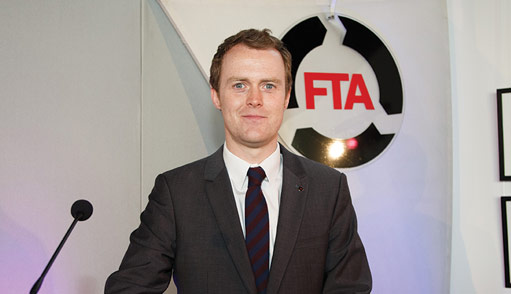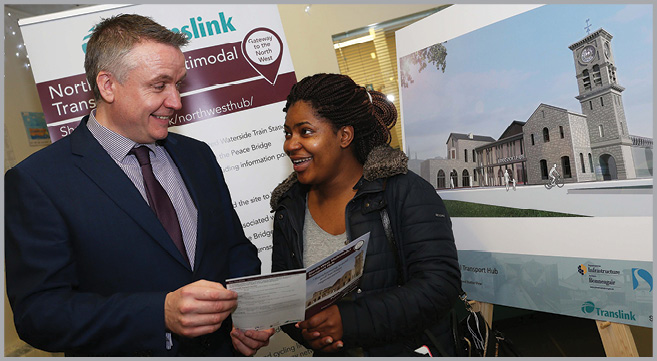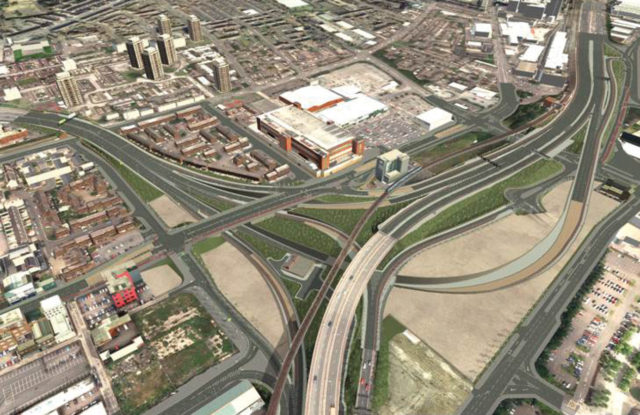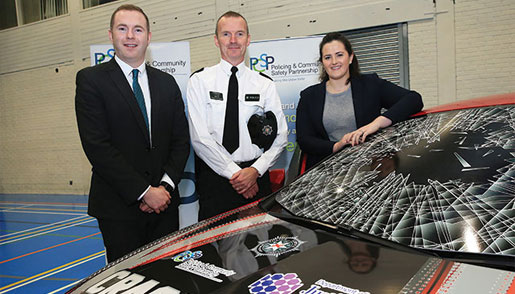Fast forward
Having inherited the rapid transit project for Belfast, Regional Development Minister Conor Murphy tells Owen McQuade that he is keen to make sure its benefits will be shared by the whole city.
When Conor Murphy took office after devolution in 2007, plans were already in place for a rapid transit system. However, with routes only planned to Titanic Quarter and to east Belfast, he asked Department for Regional Development officials to look again at the planned routes, which he felt were “very much skewed to one side of the city”.
In April last year it became clear to him that, as a business case for Belfast, segregated bus ways would bring most benefit to the city given the costs associated with construction and annual operating.
Three pilot routes are now planned, to Titanic Quarter, along the east-way to east Belfast and the west-way to west Belfast.
A report into the strategic outline business case for a rapid transit network estimated the costs of the east Belfast scheme to be £106 million for bus-based transit and £282 million for light rail. The west Belfast scheme was estimated at £35 million for the bus system and £217 million for light rail and the Titanic Quarter scheme was priced at £6 million for the bus-based system and £91 million for the light rail.
“There were some people who were disappointed and felt that the light rail option was more fitting for a modern city, but the report very clearly recommended that the bus-based operation was the most sustainable,” the Minister remarks. He also explains that the system would be designed in such a way that it could migrate into a light rail system if future passenger numbers supported it.
Like for like?
Comparing, for example, the Luas system in Dublin to a rapid transit network in Belfast, is misleading: “Bear in mind Belfast has a population of about half a million. Dublin has a population of 1.7 million so when people were looking at the Luas system, they weren’t entirely comparing like for like.”
Ciarán de Búrca, who assisted the Irish Railway Procurement Agency in providing the Luas system in Dublin, is now Director of the Belfast Rapid Transit Project. Murphy cites this as a real benefit for the project.
Although many people, rightly, look to the Luas as a very successful project, the Minister says that de Búrca’s understanding of its potential drawbacks has been an added attraction: “He was telling us that the Luas system has been very fixed in that if anything happens along the street the tracks run, the system effectively closes down, whereas the bus-based [system] has a bit more flexibility.”
That said, he adds that it is the intention to build as segregated a system as possible in Belfast, aiming to get as many people out of cars on to public transport as possible. However, the system will only work if it is more efficient than the car.
He adds: “If it’s sitting in the same traffic jams as a car, it’s not going to attract people.”
In certain circumstances, he explains, segregated lanes will not be possible and adjustments will have to be made in those areas to give priority to rapid transit vehicles.
Modal shift
He emphasises that one of the main changes to be made is attitudinal, saying the system must appear to people as something different. “It has to feel like a different experience than normal buses,” he says, citing off-vehicle ticketing, quick, frequent stops, and high frequency services as experiences that will be meet that criteria.
They should, he continues, have a modern look and feel to counteract the stereotype that “people who use buses and trains are students and pensioners, and that those in employment always opt for a car.”
Murphy points again to Dublin as an example of good practice: “In Dublin they made a conscious decision to get people out of cars. It’s a modal shift, but that’s what we’re after.” He adds that in Northern Ireland people do not see public transport as a better option and, inevitably, car numbers are growing.
The Minister admits that drivers will experience a high degree of disruption, though he concedes it may take that to entice people away from their cars. “In order to do get people there [quickly and efficiently] you have to create space for the rapid transit vehicles and, at the moment, the only space we have is car space so that space is going to have to be reduced.”
The three schemes are to be rolled out from 2012 with the Titanic Quarter scheme being the first on the ground.
As well as introducing the rapid transit system, Murphy is also looking at adding more park-and-rides around Belfast, more bus corridors and limiting parking in the city centre, all of which he hopes will discourage a significant amount of commuter traffic coming to Belfast.
He explains: “Essentially what has happened is that Belfast is de-populating and people are moving out to towns and villages outside Belfast and spending a couple of hours a day driving in and out and complaining about traffic jams.”
There will also be a reform of public transport, where the department will be looking more at a one-ticket-fits-all approach leading to a more integrated and co-ordinated system.
Twenty new Class 4000 trains are also planned to be rolled out from 2011 and will be deployed on the Derry railway line and the Belfast to Larne line.
Cross-border
The Enterprise rail service between Belfast and Dublin will also be considered. Reducing journey time and increasing frequency of the service are the ultimate aims. However, the Minister is wary that the rail line may have fallen behind the road link: “[Unless investment is made] I could see a scenario whereby it could be quicker to drive”, which he thinks would be “damaging” for public transport.
In the long term, he calculates that between 30 and 40 per cent of the population of the whole of Ireland will be living in the Belfast-Dublin corridor within the next 20 years, so that route “does beg” for investment.
He worries that finding monies for investment could prove difficult in the downturn though emphasises, at the very least, that there is a desire to improve the service on both sides. Murphy concedes that it may be more of a series of incremental changes than wholesale.
The Minister cites the new train station at Newry as integral to increasing passenger numbers but does highlight the factors which are outside of his control. On certain parts of the line the train has to slow down, most notably north of Dublin Connolly, due to congestion from both Dart and Irish Rail services, and also between Portadown and Lurgan where the line speed is significantly reduced, from 90mph to 60mph.
Roads
The significant investment put into the Westlink project has been successful, though there is still work to be done, specifically at the York Street junction, where Murphy would prefer to see a “freeflow right through” from the Westlink onto the M3.
Improvements were primarily aimed at the strategic route that connects the M1, M2 and M3 motorways and will improve traffic flow between Belfast city centre, the City and International airports and the Port of Belfast.
Rapid transit, he continues, is only one of a series of measures to try and encourage people out of cars and create a more vibrant city culture. “We want to look at why Belfast is becoming de-populated. What you’re finding is that Belfast is where the vast majority of jobs are, and well-paid jobs, but the people who are doing that aren’t necessarily living in the city.”
Investment can be made in roads but “it’s still very hard to build your way out of congestion. The M50 will tell you that.”
Finance
The first three routes: Titanic Quarter, east-way and west-way should be operational by 2012, with a projected cost of £147 million. There are also plans in place to look at potential routes in the north of the city, specifically around Crumlin Road Jail, and in south Belfast.
Although the project has been budgeted for in the Investment Strategy, the procurement of developer contributions is also being examined. Indeed there are already some contributions from Titanic Quarter although DRD was not able to quantify this amount at the time of writing.
Rapid transit will represent a new way of travel for the province’s capital. With broad support for the project, the challenges of putting it in place are mainly practical, and Murphy is determined to see it come to fruition under his watch.





